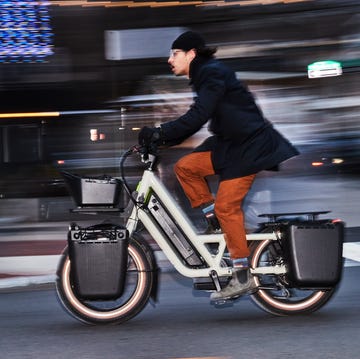We need to talk about Campagnolo.
No cycling brand has the history and lore of the Vicenza, Italy-based component maker. Other companies cannot claim the gravity Campagnolo has earned by crafting some of the most groundbreaking, beautiful, and high-performance components in cycling’s history. Pick a legendary moment or race win in cycling, and Campy was almost assuredly part of it.
That’s why the 90-year-old company has attained a more revered and beloved position than any other bicycle brand. Campagnolo certainly has its duds like Delta brakes and its mountain bike groups. But Campagnolo usually gets a pass for its missteps because it is everything great about cycling.
But while distant history is kind to Campagnolo, recent history is less so. Perhaps it is fitting that the company that gets credit for inventing the quick release is experiencing one of its most challenging moments as the QR fades from memory.
It’s hard to tell when things started to go pear-shaped. For all the talk about tradition and history, Campagnolo was aggressively forward-thinking with its products. It jumped on things like integrated shift/brake levers, employing carbon fiber, electronic shifting, wider range gearing, increased cassette cog count, and oversized crank axles early and with great products.
But Campy also had some recent misses. Many of them center on Campagnolo waffling with its identity. At times, it wants to be seen as exclusively premium equipment, which is why, in 2009, it revived the Super Record label for its highest-end group after a long absence.
But then it will suddenly try to compete for mid-range OE parts specification on complete bikes: an incredibly cutthroat world where negotiating a few pennies per derailleur can be the difference between winning and losing orders worth millions.
In the late teens, Campy invested a lot of resources into Potenza and Centaur groups, trying to compete against Shimano and SRAM for drivetrain spec on mid-range bikes. Campagnolo also tried lowering the price of its electronic shifting offerings with an Athena EPS group.
None of those groups succeeded. The reasons are likely myriad, but one of them is, as a more frank Campagnolo employee said to me, “Campagnolo can’t sell anything that doesn’t say Super Record on it.”
That statement is apparently why Campagnolo confusingly named its new, second-tier, wireless group “Super Record S” instead of applying the branding it historically has used for less-expensive products like Record, Chorus, Athena, Daytona, Centaur, and Potenza.
When it wasn’t trying to engage in spec-wars with SRAM and Shimano, Campy swung in the opposite direction and leaned into its aura as a maker of European-made, ultra-premium products. Super Record, it said, is higher-end than Dura-Ace or Red—a claim reinforced by its stratospheric price.
However, Super Record is also hard to acquire—fewer places sell it, and it is often out of stock. Campy stuff often requires specialized tools, which can be expensive and challenging to find. Serviceability and longevity were once hallmarks of Campagnolo products. But then, repair and replacement parts became hard to track down, making ownership frustrating.
Campy was also slow to adapt to an increasingly fragmented and demanding bicycle market. It was slow to provide more gearing options and shorter crank lengths, and it took Campy until this year to offer a power meter crank.
Campagnolo was also slow to address gravel riding. When it finally launched the gravel-oriented Ekar group in late 2020, it was mechanical-shift only and cost as much as some electronic-shift groups.
Four years later, Ekar is still a mechanical shift-only group. This is an era when a large and growing number of mid-to-high-end frames have zero provisions for mechanical shifting. In a less guarded moment, a bike brand representative with long-standing connections to Campagnolo told me about the lack of an electronic Ekar group: “Look, we love Campagnolo. But we can’t figure out what the f–k they’re doing.”
The Italian brand was also late to the party with disc brakes. At least part of the delay was due to Campagnolo’s “Golden Rule” which proclaimed that its premier products or new technologies must be race-proven at the highest levels of the sport before they can be sold to the public. However, the consumer market evolves much faster than the UCI’s glacially slow equipment approval policies. Disc brakes were on the market and widely accepted by riders several years before the UCI allowed their unfettered use in competition.
The UCI says it moves slowly and is conservative because it wants bicycle racing to be athlete against athlete and not a battle of equipment and technology. Whether you agree with the UCI or not, one can at least understand the position. But as cycling equipment diversified beyond replicas of drop-bar skinny-tire race bikes, Campy’s Golden Rule became a roadblock.
Campy had to abandon its rule with disc brakes because customer demand was so strong. Right around that time, you also saw Campagnolo’s presence in the professional peloton start to wane. Was it Campy pulling back? SRAM and Shimano outbidding for sponsorship? Or maybe teams didn't want to use Campy because the brand didn’t offer the products the racers needed?
The answer is probably some combination of all three. Whatever the reason, no UCI World Teams used Campagnolo for the 2024 season. That is a painful blow for a brand with such a proud and successful racing history.
While all of the above have been simmering in my mind for a while, some observations I had at the MADE show in Portland, Oregon cemented my frustrations with Campagnolo’s current state.
Campagnolo had a booth at MADE. If any show is perfect for Campy, it is a bike show full of boutique frame builders and customers willing to shell out for premium cycling gear. But the Campy booth—technically, the Campagnolo North America booth—was a sad sight.
It was dark and lonely. A messy pallet of Campy-branded cans of sparkling water stood in one corner. The brand’s space was often unoccupied, and when it was staffed, it was usually by someone slumped in a chair staring at their phone. The booth had a bike or two, but they were poorly lit and uninteresting. It felt grim.
Campagnolo was hardly present on bikes in custom manufacturers’ booths. Finding a Campy-equipped bike at MADE was like a “Where’s Waldo” search in a sea of SRAM and Shimano.
But what pushed me over the edge was the ride I took on Campagnolo’s new Super Record S group. If you haven’t read Dan Chabanov’s well-done test of Campagnolo’s Super Record Wireless group, you should. Even though it pains me to say so, I heartily cosign Dan’s review.
Like Dan, I remember when Campagnolo’s road groups were the pinnacle of style and performance. Its groups were more than beautiful and light: Campy pushed boundaries and brought real innovation to the market. I felt like I arrived as a cycling tech journalist when I was deemed worthy enough to review an Italian bike with Campagnolo Record 10 Ergopower.
Campagnolo is a much smaller brand than Shimano and SRAM and the Italian brand has fewer resources at its disposal. But that underdog position, combined with its heritage and past ability to compete with the bigger brands and occasionally outfox them, keeps me rooting for them.
In the past, I found Campy usually takes a different journey than SRAM and Shimano. But ultimately, it ends up with parts that offer performance that competes against and occasionally exceeds the competition.
When I ride a new Campy group for the first time, I expect some Campy quirks—magnetic battery strap to turn off your shifting? Ha, ha, that’s just Campy being Campy! Yet I always expect to ride the group and think, “I want this stuff on my bike.” That all seems so long ago.
I was granted an opportunity to ride the Super Record S group—essentially identical to Super Record Wireless with a different finish and a few heavier and cost-saving details—ahead of its recent launch. Unfortunately, I finished the ride happy that I did not have these parts on any of my personal bikes.
The stacked shift paddles are almost impossible to differentiate and feel cheap when pressed. I suspect they’ll be a nightmare when riding with winter gloves. The brake levers feel flexy and sluggish and provide little feedback. The brakes offer good power and modulation, but it’s hard to be excited when the levers feel so blah.
And as Dan noted in his review, the shifting performance is all over the place. Sometimes, it’s okay, although it desperately lacks the polish of Dura-Ace Di2 or SRAM’s new Red. And other times—frequently, unfortunately—it’s noisy, slow, and jarring.
The front shifting is especially troubling—It is glacially slow and inconsistent. Several times the derailleur just mashed the chain against the ring when I tried to shift to the big ring, rasping but never picking up.
The hoods are very nice, though, so there’s that. But the accessory buttons on the hoods are amazingly unintuitive. The Campy rep who handed me the bike to ride told me not to touch these buttons because it might cause pairing issues. What? How is that okay?
I can’t figure out what's going on with the H.R. Giger does Mecha-art styling, either. One of the joys of Campy was that installing it made a bike look better. I can’t think of any bikes that would look better with this group.
Judged strictly on the merits of shifting performance and control feel and function, Shimano’s 105 Di2 and SRAM’s Rival AXS are leagues better. And when you factor in price (and Campy’s absurdly expensive power meter option), I’m left feeling that Campy’s Super Record is reduced to a rich person flex: Something you buy simply to say you spent more than anyone else.
I took no joy in typing any of the previous words. I am a Campagnolo fan. I’ve met and worked with many wonderful Campagnolo employees—there are good, intelligent people there. And no other cycling brand enjoys the support and love that Campagnolo does.
The bike world is better when Campagnolo thrives. I want to want Campy on my bike. I want the Italian legends to bring the fight to Shimano and SRAM. Without Campagnolo, Red and Dura-Ace would not be as good as they are today
However, the brand has a mountain of work to become the Campagnolo of old again. I worry that the brand exists on borrowed time, but I still believe in Campy. I have to believe it can meet this challenge and thrive again.
Because I can’t imagine cycling without Campagnolo.

A gear editor for his entire career, Matt’s journey to becoming a leading cycling tech journalist started in 1995, and he’s been at it ever since; likely riding more cycling equipment than anyone on the planet along the way. Previous to his time with Bicycling, Matt worked in bike shops as a service manager, mechanic, and sales person. Based in Durango, Colorado, he enjoys riding and testing any and all kinds of bikes, so you’re just as likely to see him on a road bike dressed in Lycra at a Tuesday night worlds ride as you are to find him dressed in a full face helmet and pads riding a bike park on an enduro bike. He doesn’t race often, but he’s game for anything; having entered road races, criteriums, trials competitions, dual slalom, downhill races, enduros, stage races, short track, time trials, and gran fondos. Next up on his to-do list: a multi day bikepacking trip, and an e-bike race.


















